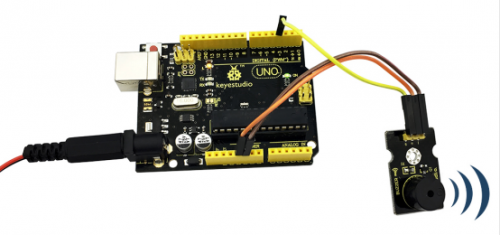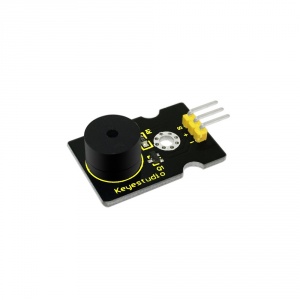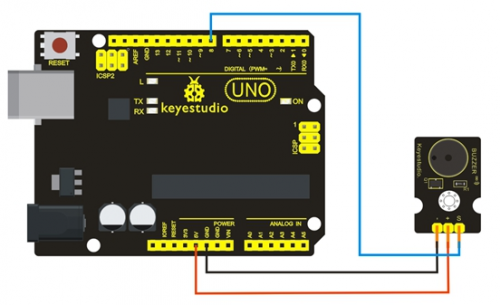Ks0019 keyestudio Passive Buzzer module: Difference between revisions
Keyestudio (talk | contribs) |
Keyestudio (talk | contribs) No edit summary |
||
| Line 4: | Line 4: | ||
==Introduction== | ==Introduction== | ||
We can use Arduino to make many interactive works of which the most commonly used is acoustic-optic display. All the previous experiment has something to do with LED. However, the circuit in this experiment can produce sound. Normally, the experiment is done with a buzzer or a speaker while buzzer is simpler and easier to use. The buzzer we introduced here is a passive buzzer. It cannot be actuated by itself, but by external pulse frequencies. Different frequencies produce different sounds. We can use Arduino to code the melody of a song, which is actually quite fun and simple. <br> | We can use Arduino to make many interactive works of which the most commonly used is acoustic-optic display. All the previous experiment has something to do with LED. However, the circuit in this experiment can produce sound. Normally, the experiment is done with a buzzer or a speaker while buzzer is simpler and easier to use. The buzzer we introduced here is a passive buzzer. It cannot be actuated by itself, but by external pulse frequencies. Different frequencies produce different sounds. We can use Arduino to code the melody of a song, which is actually quite fun and simple. <br> | ||
==Specification== | ==Specification== | ||
| Line 11: | Line 10: | ||
* Size: 30*20mm | * Size: 30*20mm | ||
* Weight: 4g | * Weight: 4g | ||
==Connection Diagram == | ==Connection Diagram == | ||
| Line 42: | Line 40: | ||
</pre> | </pre> | ||
After downloading the program, buzzer experiment is finished. | After downloading the program, buzzer experiment is finished. | ||
<br>[[File:Ks0019-1-.png|500px|frameless|thumb]]<br> | |||
==Resources == | ==Resources == | ||
Revision as of 16:47, 20 March 2018
Passive Buzzer Module
Introduction
We can use Arduino to make many interactive works of which the most commonly used is acoustic-optic display. All the previous experiment has something to do with LED. However, the circuit in this experiment can produce sound. Normally, the experiment is done with a buzzer or a speaker while buzzer is simpler and easier to use. The buzzer we introduced here is a passive buzzer. It cannot be actuated by itself, but by external pulse frequencies. Different frequencies produce different sounds. We can use Arduino to code the melody of a song, which is actually quite fun and simple.
Specification
- Working voltage: 3.3-5v
- Interface type: digital
- Size: 30*20mm
- Weight: 4g
Connection Diagram
Sample Code
int buzzer=8;//set digital IO pin of the buzzer
void setup()
{
pinMode(buzzer,OUTPUT);// set digital IO pin pattern, OUTPUT to be output
}
void loop()
{ unsigned char i,j;//define variable
while(1)
{ for(i=0;i<80;i++)// output a frequency sound
{ digitalWrite(buzzer,HIGH);// sound
delay(1);//delay1ms
digitalWrite(buzzer,LOW);//not sound
delay(1);//ms delay
}
for(i=0;i<100;i++)// output a frequency sound
{
digitalWrite(buzzer,HIGH);// sound
digitalWrite(buzzer,LOW);//not sound
delay(2);//2ms delay
}
}
}
After downloading the program, buzzer experiment is finished.

Resources
Video
http://www.keyestudio.com/wp/2016/05/ks0019-keyestudio-passive-buzzer-module/
Datasheet
https://drive.google.com/open?id=1al1MJhVE6ObEOGmsg31O0NANxWcITDP2
Buy from
Official Website
http://www.keyestudio.com/keyestudio-passive-buzzer-module.html
Amazon Store

